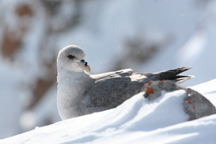 Although the Arctic
most often calls to mind pristine landscapes of snow and ice, researchers have
followed the slow accumulation of human-made chemicals to these northernmost
ecosystems over the past few decades. In the early 1990s, biologists confirmed
that polar bears and native people carry in their fat tissues large amounts
of PCBs, a carcinogenic material used in electrical equipment as a coolant and
for other purposes. The dangerous chemicals accumulate in mammals at the top
of the food chain, as they eat fish and other food stuffs that store the fat-loving
chemicals in their own tissues.
Although the Arctic
most often calls to mind pristine landscapes of snow and ice, researchers have
followed the slow accumulation of human-made chemicals to these northernmost
ecosystems over the past few decades. In the early 1990s, biologists confirmed
that polar bears and native people carry in their fat tissues large amounts
of PCBs, a carcinogenic material used in electrical equipment as a coolant and
for other purposes. The dangerous chemicals accumulate in mammals at the top
of the food chain, as they eat fish and other food stuffs that store the fat-loving
chemicals in their own tissues.Seabirds in the Arctic act as “funnels,” concentrating toxic chemical compounds collected from elsewhere and carried in their excretions into “hot spots” in terrestrial Arctic ecosystems, on land and in freshwater lakes. This photo of an Arctic fulmar is courtesy of Mark Mallory.
The Arctic Monitoring and Assessment Programme, conducted by a consortium of Arctic nations, found concentrated pollutant “hotspots” in the region, showing that this so-called bioaccumulation is not limited to animals, but extends to land-based ecosystems too. A new assessment of seabirds and their guano sheds light on these mysterious hotspots.
Seabirds, like polar bears and people, are at the top of their local food chains, eating fish, plankton and squid. Those creatures collect chemicals that atmospheric and ocean currents deliver from elsewhere on the planet; once eaten, the once widely dispersed chemicals are then further concentrated in the birds’ guano. The birds “are concentrating these chemicals that are already biomagnified under the sea foodweb,” says Jules Blais, a biogeochemist at the University of Ottawa.
Blais and his co-workers tracked northern fulmars, which have gull-like plumage, living on Devon Island in an archipelago between Canada and Greenland, finding that the birds foraged over a large area. But the birds nest “in a relatively small area,” Blais says, “acting like funnels that concentrate these chemicals in hotspots of biological activity.” Dropping their feces on cliff faces, the nesting birds support terrestrial ecosystems while also affecting nearby freshwater lakes, which are home to algae and insects that support snow buntings, small birds in the area that may in turn support foxes.
Concentrations of DDT, mercury, hexachlorobenzene and other toxic compounds in these lakes’ sediments correspond to the levels in the birds’ guano, and both levels are higher than expected for only atmospheric deposition — up to 60 times more for DDT and its metabolites in particular. Blais and his co-workers confirmed their results using stable isotope ratios of nitrogen and carbon. Published in the July 15 Science, the findings may have broad implications “because these chemicals exert [high-toxicity] effects when concentrated,” Blais says, potentially affecting terrestrial animals, insects and plants in the region.
Roland Kallenborn, a biochemist at the Norwegian Institute for Air Research in Kjeller, says that Blais and his co-workers “might have found the mechanism of transfer” from marine to lake settings, something that has long been theoretical, while showing that “the birds are very effective.”
For the Arctic as a whole, this guano transport system may not be a huge delivery mechanism, says David Schindler, a biogeochemist and limnologist at the University of Alberta in Edmonton, who was not involved with the research. Still, he says, “guano deposits are significant biogeochemical features,” which can have a “significant effect on the geology as well as the chemistry of these systems.” Although guano’s addition of nutrients to ecosystems has been known “for years and years,” he says that “we’ve forgotten all the things other than nutrients.”
Schindler and others suspect that this story will continue to play out in other locations as well. For example, in his own research on cormorants living on small lakes in Canada, Schindler says, the higher nutrients feed algal blooms that suck oxygen out of the water during winter, killing off the fish. Other researchers from the University of Wisconsin have found farm chemicals deposited from migrating birds in the southwestern United States. “It makes me wonder how many other contaminants these birds are carrying off to other locations,” Schindler says.
Naomi Lubick

